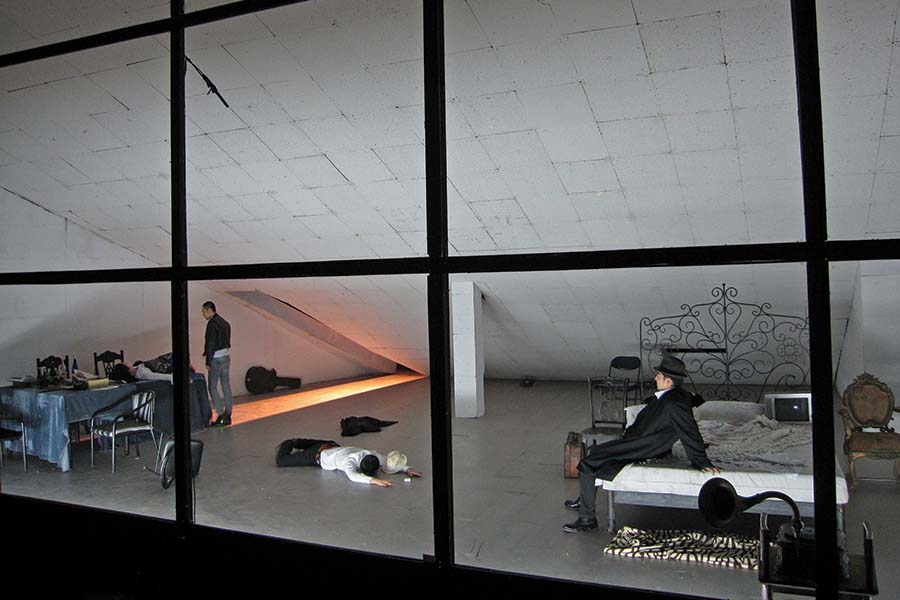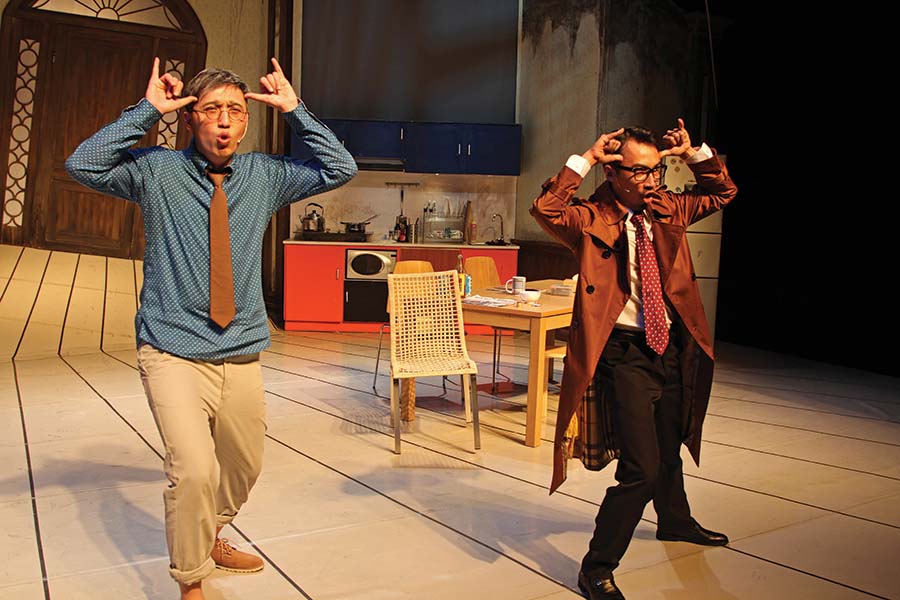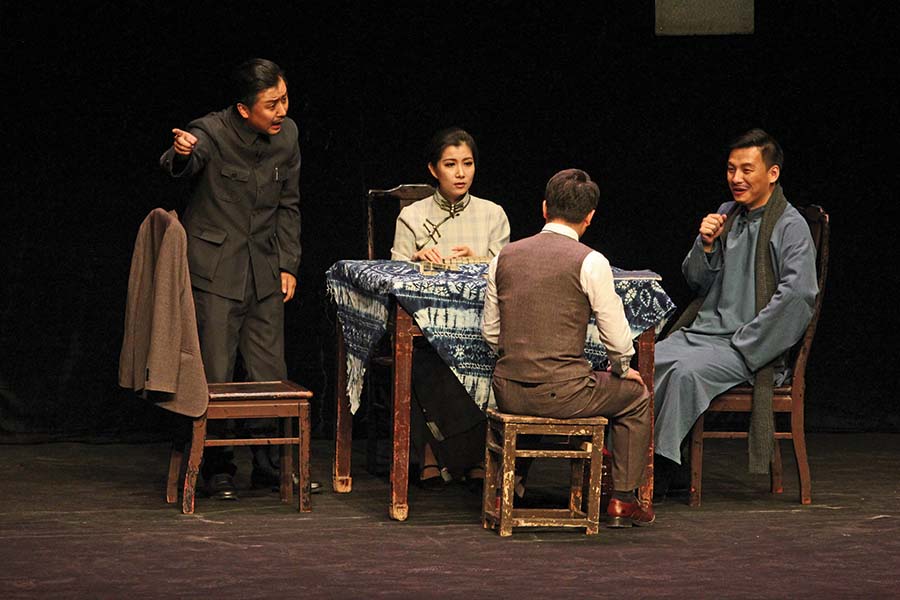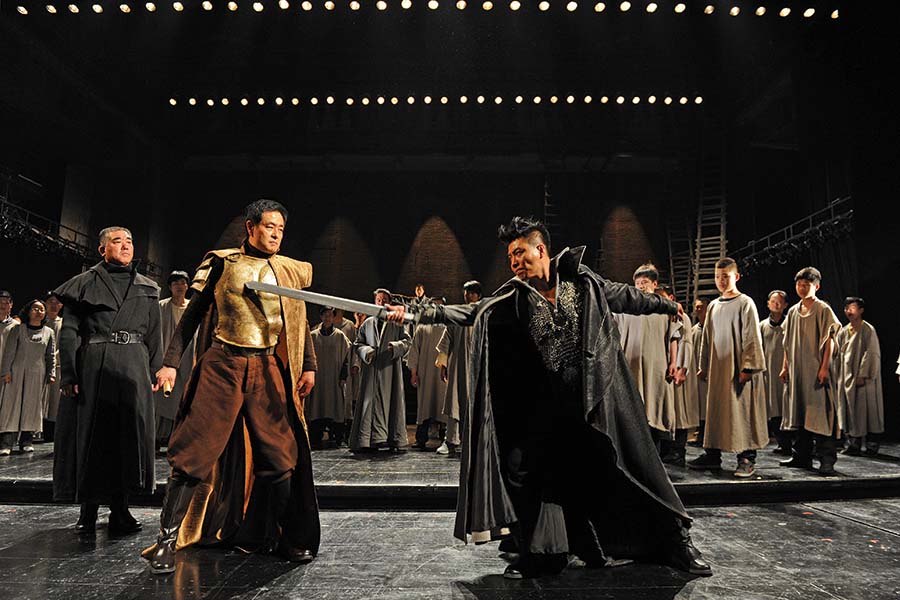Unlike China’s film industry, which is constantly in the limelight, Chinese theatre enjoys the benefits of the shadows, so to speak. Without the tight scrutiny of the public or the censors, it has mushroomed into an art form with an almost unimaginable range of diverse works. On the other hand, most of these have failed to find even a limited audience, let alone commercial viability.
According to an official report, Beijing alone saw 24,440 live performances for the year 2016, registering 1.7 billion yuan ($247.7 million) in box-office receipts and 10.7 million total viewers. Pop concerts accounted for 593 million yuan, the biggest category, followed by various dramatic arts, with 260 million yuan.
Beijing has the highest concentration of both venues and performances. One should, however, refrain from extrapolating the Beijing figures to the rest of China, in a Broadway-to-U.S.-regional-theatre fashion. Live performance as we typically define it has been absent from much of the country for decades. The ubiquitous Chinese operas of olden times have turned simultaneously into a social stigma, à la “your grandma’s pop tunes”—a heritage item promoted by the government. And spoken drama, though on the rise, is an endeavor very much confined to a dozen or so big cities and appealing to a young and well-educated demographic.
In sheer numbers, the most popular form of live performance is the variety show, staged by local governments for festive occasions like the National Day. The production values can be surprisingly lavish, because government organizations tend to foot the bill (and often pass it to corporate sponsors). Tickets are distributed, not sold. There is no intention to recoup the cost. Everything is modeled on the big galas of the national television station, from the choice of songs to the choreography to the speech patterns of the hosts. If you’ve seen one, you’ve seen them all.
Another widespread genre of performance with no financial value is the “square dance,” so called because it takes place in public squares and attracts a predominantly elderly and female crowd. Often seen as a fitness routine, it is a throwback to the old days of Maoist China, when the music and the movements had a quasi-military bent. There is little trace of artistic aspiration, but some are better choreographed than others.
The ubiquitous variety show has a sibling that is very much profit-oriented, usually customized for a tourist destination and featuring Las Vegas-style glitz. Filmmaker Zhang Yimou has thrown his weight—and name—behind half a dozen such projects, all under the title “Impressions.” The most successful, however, is the Hangzhou-based Songcheng theme park, which presents a 70-minute show in its two adjourning theatres as many as 15 times a day to an annual viewership of seven million.
In spite of all the wannabes, though, China may not yet be ready for a top-notch Vegas spectacle. The “Han Show” would stand out even on the Vegas Strip, but in the central Chinese city of Wuhan the project, with its imported designers and cast, is just too expensive to sustain a profitable run, even for the deep-pocketed Chinese multinational conglomerate Wanda Group.

Strings Attached
After the Communist Party came to power in 1949, all performing-arts organizations were owned by the state, which strictly controlled programming. The repertory was extremely limited, but penetration was unprecedented, often reaching even the smallest villages.
The end of the Cultural Revolution in 1976 ushered in a new era, with competition from television and a gradual introduction of private capital into the industry. These days the most popular shows are invariably produced by the private sector. Mahua FunAge, a private enterprise founded in 2003, has produced a string of stage comedies with a total of 4,000 performances across China. It is also the first live-performance company that has branched into the realm of the silver screen, with a film adaptation of one of its stage hits, Goodbye Mr. Loser, which in 2015 became a box-office dark horse, with 1.44 billion yuan in receipts.
Less commercial and more artistically aspiring is Magnificent Culture, a private company that has produced the eight-hour epic A Dream Like a Dream and the soul-searching The Winter Journey. (Full disclosure: My play The Ring Road has been produced by Magnificent Culture.)
But despite the energy generated by the private sector, state-funded companies still represent a juggernaut to be reckoned with. They have access to the best resources, including the venues they tend to own outright and the talents they have on their payroll. They also have a shortcut to awards and prizes and subsidies.
People in Western countries, particularly the U.S., may feel envious of a government that throws its weight behind the arts. But the support comes with strings attached. Public companies tend to toe the line of “political correctness” to the point of timidity. Usually only classics and “safe” content will be considered.
But the most dubious result of state-supported theatre is its subversion of market forces. When over-subsidized works enter the market, they drive up the costs for privately funded shows. Most state-owned venues have little concern for supply and demand: They simply dangle a rental rate much higher than normal and end up being unused for most of the available days, which does not upset the management, whose salaries are not affected. Many such big-city theatres are rented only by cash-flush businesses for one-off events, such as product launch parties.
The existence of a powerful but less than artistically vigorous public sector in the theatre business is a throwback to the 1980s, when most industries operated in a dual system, with a heavily subsidized public sector locked in unfair competition with an emerging yet chaotic private one. But unlike those industries, which eventually phased into the market economy, the culture industry, of which live performance constitutes a small portion, may never see the days of a completely free market. The reason is simple: The government will never view culture as simply an entertainment product.
It would be wrong, however, to brush aside all state-funded works as pure propaganda. For all their conservatism, venerable organizations such as Beijing People’s Art Theatre and the National Theatre Company of China, also in Beijing, are instrumental in educating the public about the beauty of performing arts with seriously and meticulously produced plays, including such American classics as Death of a Salesman, The Crucible, and Plaza Suite. These often represent the theatrical mainstream, and market players have to adjust to their positioning by offering different fare from these heavyweights.

Runs and Habits
The length of theatrical runs may be one of the biggest differences between China and the United States. A Streetcar Named Desire, say, ran for 855 performances in its original Broadway production in 1947, and has had countless performances since. By comparison, Lao She’s Teahouse, arguably the most celebrated straight play in China, had totaled 500 performances by 2005—since its 1958 premiere.
Most Chinese plays and musicals adopt a rollout strategy similar to opera productions in the U.S. A new production usually opens with a dozen performances or less. If it is well received, it will be revived at a later time—maybe in a year or so. Stan Lai’s Secret Love in Peach Blossom Land opened in mainland China in 2006, and the star-studded production has since ratcheted up 200 performances in a decade, often touring different cities for a few weekends each year. (Since it originated in 1986 in Taiwan, the play has totaled about 900 performances worldwide, including 75 at the Oregon Shakespeare Festival in 2015. There have been at least 1,000 unlicensed student performances on China’s college campuses.)
This is a testament to the habit of theatre attendance in China. Theatregoing is not yet a mass entertainment. It appeals mostly to the young, well-educated, and urbane. And it is an activity that, with rare exceptions, draws people only on or close to the weekend.
In recent years, some musical producers with deep pockets intended to change that. They licensed classic titles from Western countries and opened with a run of one month or longer. Most had their hopes mercilessly dashed. Into the Woods opened an extravagant Chinese production in late 2014 with an astounding 100-show run—and it was reported that some performances had fewer audience members than cast members.
As a result of short runs and periodic revivals, a successful show incurs higher per-performance costs than a long run in one venue would. But it is doubtful the situation will improve dramatically, at least not in the near future. Looking at the consumption habit of cultural products in China, it’s tempting to conclude that not only is the audience size small; its attention span is also short.
You might think that musicals would enjoy more popularity in China than in a Western country, given that variety shows feature mostly singing and dancing (including a token nod to opera as a gesture toward cultural heritage), while spoken drama’s history in China is only about a century old.
But the opposite is true. Musicals have yet to develop into a bona fide genre in the Chinese theatre. There have been numerous efforts to kick-start it through foreign touring productions, local productions of licensed shows and domestic offerings, but one can count the number of genuine hits on two hands. As a result, the assumption that musicals have broader appeal than spoken drama, which is generally applicable in the U.S., has to be reversed in China. With higher production costs and lower audience turnout, those who launch musical projects in China can consider themselves pioneers, risk takers blazing a trail for future generations. In the year 2016, according to Dao Strategy, a research firm that specializes in China’s performing-arts market, the total box-office receipts for performances of musicals, including foreign companies touring China, reached 174 million yuan—23 percent lower than 2015. Total attendance was little over a million.
Pop singers who can be marquee names have shown little interest in headlining musicals, for one thing. They can garner far more money and exposure through telecasting in government-backed variety shows. And the higher professional demands and lower compensation in musical theatre also combine to be a big turnoff for them.
One reason for the malaise lies in the difficulty in market positioning. The putative broad appeal of the musical form has the unintended result of the public equating it with opera, an off-putting high-brow endeavor for many. Sung-through musicals like The Phantom of the Opera and Les Misérables have only added to the confusion. (Opera productions, on the other hand, attract a predominantly young and educated audience who know clearly what they want. While the size of China’s classical music market is grossly exaggerated in the West, graying of its target audience is of least concern in China.)
Traditional Chinese opera, with its hundreds of local variants, has been in the throes of transformation for the past few decades. Most have lost their élan vital, their life force. As the staple of live entertainment before the age of television, Chinese operas have been fossilized into museum pieces with dwindling numbers of actual ticket buyers. A few exceptions include the 500-year-old Kunqu, the oldest extant form and on the list for UN heritage protection; Peking Opera, widely considered the national opera; and Yueju, popular in Shanghai and its vicinity, especially with elderly women.
A handful of opera artists have been trying to reinvent their art form and connect with the youth demographic. Some of their innovations have resembled techniques from typical musicals. But they are bound by conventions in singing, which has to hew to a certain style, and pronunciation, which has to be that of a certain dialect. It is ironic that while many Chinese scholars have defined traditional opera as an early incarnation of the musical, any deviations by opera innovators that approach the sound of the modern musical are denounced by purists.
Children’s shows are usually de facto musicals, though they are not advertised as such. Generous spending by Chinese parents on their only children has turned it into a very profitable and independent genre. But it is marred by the deluge of fly-by-night operations. If the Chinese production of Disney’s Lion King could be retooled for high-frequency touring, it may set a new standard in quality.

Speak the Speech
Spoken drama was a foreign import. An early anecdote illustrates the form’s strangeness: At one play in a rural area, audience members kept chatting away after the play started. Asked to keep silent, they replied in shock, “Don’t worry. The show has not started yet. The actors onstage are still talking.”
In a sense, China has not moved far away from that age. The public expects a high degree of stylization when they go to the theatre, which is very different from their expectation of films.
The introduction of straight plays into China coincided with the boom of realism as the reigning aesthetic on the world stage. So early Chinese spoken dramas conformed to the rules of classical unities influenced by Ibsen. Cao Yu’s Thunderstorm (1937) is a prime example of this blending of classicism and realism, powerfully shaping public perception of what a play should be. Together with Teahouse, it spawned numerous imitations, some of which have become classics themselves.
The hold of these conventions was not broken until the late 1980s and early 1990s, when Lin Zhaohua introduced an abstract and expressionistic style, and Meng Jinghui held up the avant-garde banner. Lin was inspired by traditional Chinese operas, which, for all their elaborate costumes, had few sets or props; for his part, Meng had heavy Western influences. Despite the frowns of the old guard, their works opened the eyes of many theatregoers and reinvigorated the art form for new enthusiasts.
Stan Lai, in Taiwan, and Beijing’s Tian Qinxin may be less subversive in their approaches, but their plays incorporate strengths from new artistic expressions, both Chinese and Western. As devout Buddhists, these two also bring a depth that results from years of inner reflection, which distinguishes them from a pack of young artists with more exuberance than formal maturity.
Small theatre, defined as 600 seats or less, is arguably the most vibrant segment, with hundreds of new productions each year (some of which are obviously not quite ready for the opening night). Without big names attached, though, it’s hard for shows to break out. A few exceptions, such as Mr. Donkey, from the small Beijing-based comedy company Beijing Joyway Culture, and The President’s Invitation (The Face of Chiang Kai-shek), a student play from Nanjing University and written by a junior of the school, are dark satires about the loss of innocence that couch sharp social criticism in period details. Both plays are safely set in pre-1949 China, with Mr. Donkey telling the story of a rural school that keeps a donkey on its payroll to bamboozle the government and later an American philanthropist, and The President’s Invitation depicting the dilemma of three professors who must decide whether to accept or reject an unpopular leader’s dinner invite. (Imagine, say, a mildly liberal pop star getting an invitation to sing for Trump.)
One can get away with much more in these small venues than in any other medium. But censorship can still creep in: Both have had many national tours, but were unofficially barred from Shanghai. Even shows that close for nominally technical reasons are seen by some in the know as failed attempts to cross the invisible line of official acceptance.
Politics and sex are the two major content areas that can be seen as “troublesome” by government censors. One way to avoid this pitfall is through indirectness. A playwright who wants to use a taboo word can call it something else while artfully framing the context so that every audience member with a brain will know what they’re referring to. This applies to content as well. This indirection has helped carve out much more leeway for expression.

A Fight in a Cocoon
Beijing registered close to 9,000 performances of plays and children’s shows in 2016. The figure was not further broken down. But clearly the most important ingredient in a play’s success is its so-called “brand.” Does it have big-name stars, director, or a production company? Often it helps if the show is based on a best-selling book. Some of the huge productions presented in 3,000-seat houses are adaptations, drawing crowds that would not otherwise step into a theatre. Artistically, however, these are unbearably crude.
On the other hand, the core theatregoing audience, swayed by word of mouth, eagerly flocks to foreign touring productions of classic plays. Germany and some East European countries are probably overrepresented, and their unorthodox stagings have helped to push the limit of theatrical expression to the point that many can no longer accept an “unimaginative” production. When the Royal Shakespeare Company presented three of the Bard’s history plays in Beijing in 2016, the collective yawn was almost resounding.
It is difficult, in short, for a Chinese theatre lover to see the forest for the trees. The repertory on the stage is bafflingly rich, yet it takes a wise explorer to find the best of it. Advertisers will do anything to sell more tickets, so mislabeling is common. A traditionalist who goes to something called Romeo and Juliet may encounter a virtual rock concert with thin narrative strands. A plot-driven story could come off more like poetic rumination. One can be overwhelmed by possibilities but fail to make any meaningful discoveries. In a sense, the morbid attachment to “brand name” productions is but a natural corollary of selection anxiety and safe bets.
The drive for innovation and the inertia of convention and formula are two forces that never cease to fight for supremacy on Chinese stages, especially in the area of spoken drama. It is a fight that injects vitality into the art form, but it takes place within a realm that often functions as a self-contained cocoon. At many Beijing shows, one bumps into the same “friends and family” circle of audiences, applauding out of politeness for the occasion rather than out of awe for the pieces of work we’ve seen.
This push-pull also applies with the non-regular audience. For almost every work with rave reviews, there might be an equal number of detractors. Consensus is a rare commodity. It seems that every theatre critic comes from a different school of aesthetics, and their year-end Top 10 Lists have little or no overlap with those of their peers. Awards and prizes are essentially monopolized by the powers that be, and are thus anything but inclusive.
There are gems swept up in this tidal wave of creativity, but it takes time and patience to winnow them out. If future historians are like today’s critics, they will see this phase of Chinese theatre as either a dawning age of abundance, or fallow years with little work of lasting greatness. There is no denying, however, that ours is an era of boundless energy on the stage.
Raymond Zhou is a Beijing-based bilingual writer and critic, specializing in film, theatre, and cultural topics.
A version of this story appears in the May/June 2017 issue of American Theatre.


